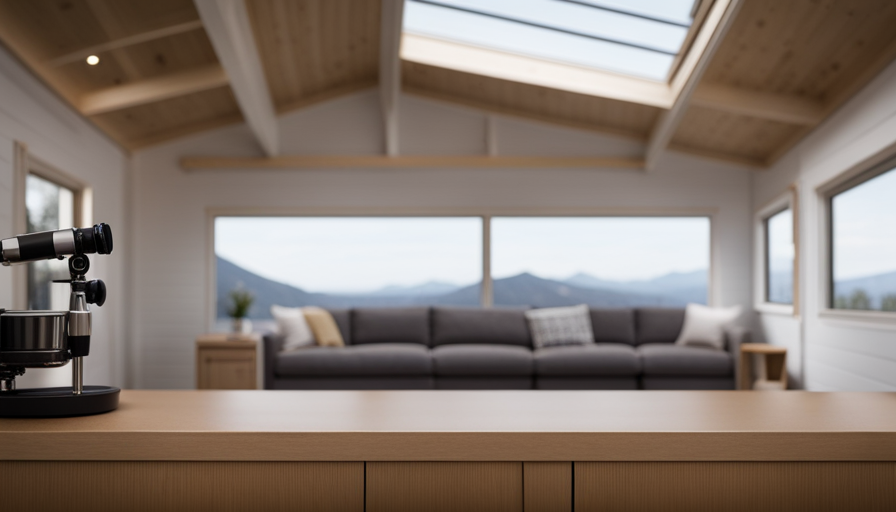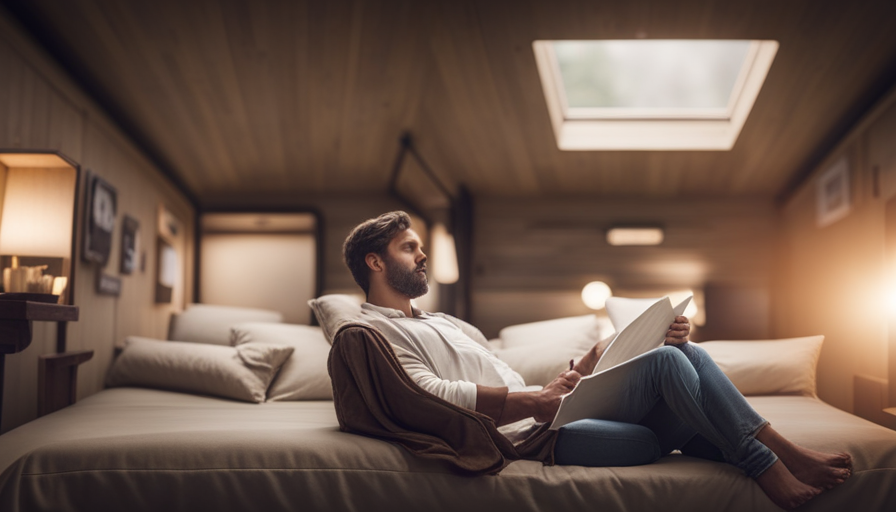Have you ever considered the idea of living in a small mobile home? The idea of being able to move your home to any location you desire is exciting and intriguing. But the question remains, is it feasible to live in a tiny house while it is being transported? The answer is yes – it is indeed possible!
In fact, there are many advantages to living in a mobile tiny house. Not only does it give you the freedom to travel and explore new places, but it also allows you to live a more minimalist and sustainable lifestyle. However, there are some safety considerations and design elements that need to be taken into account when living in a moving tiny house.
In this article, we will explore the construction, safety, and design aspects of living in a mobile tiny house, as well as provide tips for moving your tiny house safely and efficiently. So, if you’re curious about the ins and outs of living in a tiny house on wheels, keep reading!
Key Takeaways
- Living in a mobile tiny house allows for freedom and flexibility in travel and exploration.
- Safety precautions, such as proper weight distribution and securing belongings, are necessary during transit.
- Designing a functional interior requires securely anchoring and storing items.
- Maximizing organization is crucial in a mobile tiny house, utilizing vertical space and multi-functional furniture.
The Advantages of a Mobile Living Space
You can live comfortably in a tiny house while it’s on the move, enjoying the freedom and flexibility of a mobile lifestyle.
One of the major advantages of a mobile living space is the ability to travel and explore different locations without the hassle of packing and unpacking. It allows you to have your own cozy space wherever you go, eliminating the need to rely on hotels or rentals.
Additionally, the mobility of a tiny house allows you to experience nature and beautiful landscapes up close, as you can park your house in scenic locations. It also promotes a minimalist lifestyle, as you need to carefully choose your belongings, making the most of the limited space available.
Understanding the construction of tiny houses on wheels is essential to ensure stability and safety while on the move.
Understanding the Construction of Tiny Houses on Wheels
Exploring the intricacies of constructing compact dwellings on wheels can be an awe-inspiring journey. The construction of tiny houses on wheels presents unique challenges due to their limited space and need for mobility. Builders must carefully consider weight distribution, structural integrity, and efficient use of materials to ensure a safe and functional living space.
Additionally, maintenance requirements for mobile tiny houses vary from traditional homes. Regular inspections and upkeep of the trailer, wheels, and towing equipment are crucial to prevent issues during transport. Furthermore, the compact nature of these homes necessitates thoughtful design choices to maximize storage and optimize living areas.
As we delve into the construction aspects, it is important to consider the safety considerations when living in a moving tiny house, ensuring a secure and comfortable experience on the road.
Safety Considerations When Living in a Moving Tiny House
As we navigate the challenges of constructing compact dwellings on wheels, it’s essential to address the safety concerns that arise when living in a mobile tiny home. Safety precautions should be a top priority to ensure a secure and comfortable living environment.
One important aspect to consider is weight distribution. Properly distributing the weight within the tiny house is crucial to maintain stability while on the move. This can be achieved by carefully placing heavy items near the center of the trailer and avoiding excessive weight on one side.
Additionally, securing furniture and other belongings is vital to prevent them from shifting during transit. By taking these safety precautions, we can enjoy the freedom of a mobile lifestyle without compromising our well-being.
Now, let’s delve into designing a functional and secure interior for a mobile lifestyle.
Designing a Functional and Secure Interior for a Mobile Lifestyle
To create a functional and secure interior for your mobile lifestyle, make sure that every item and piece of furniture is securely anchored and properly stored. Mobile living design requires careful consideration of space limitations and the need for stability during movement.
Utilize secure storage solutions that maximize space efficiency and prevent items from shifting during transit. Install built-in shelves, cabinets, and drawers that can be securely closed or latched. Use straps or bungee cords to secure larger items like chairs or appliances. Consider using non-slip mats or adhesive strips to prevent items from sliding or falling off surfaces.
Additionally, choose furniture that’s lightweight yet sturdy and can be easily secured or folded when not in use. By incorporating these design elements, you can create a safe and functional interior that withstands the challenges of a mobile lifestyle.
Now, let’s explore some tips for moving your tiny house safely and efficiently.
Tips for Moving Your Tiny House Safely and Efficiently
When it comes to safely and efficiently moving your compact dwelling, one interesting statistic to keep in mind is that tiny houses on wheels typically weigh between 10,000 to 20,000 pounds, depending on their size and materials used. This weight can pose some unique challenges, but with the right preparation and organization, you can ensure a smooth and secure move.
One advantage of downsizing to a tiny house is that it allows for easier maneuverability on the road, as well as reduced fuel consumption compared to larger homes. To ensure a safe move, it’s important to properly distribute the weight inside your tiny house, securing any loose items, and removing any fragile objects.
Additionally, creating a checklist and organizing your belongings will make the packing and unpacking process more efficient. By following these tips for organizing and moving your tiny house, you can enjoy the advantages of a mobile lifestyle.
As we delve into legal and regulatory considerations for living in a moving tiny house, it’s important to be aware of the guidelines and restrictions that may apply to your specific location.
Legal and Regulatory Considerations for Living in a Moving Tiny House
Take note of the legal and regulatory considerations you need to be aware of before embracing the freedom of a mobile lifestyle in your compact dwelling.
When living in a moving tiny house, there are several legal implications to consider. Each state and municipality may have different regulations regarding zoning, parking, and building codes for tiny houses on wheels. It is important to research and comply with these regulations to avoid any legal issues.
Additionally, insurance requirements should not be overlooked. Insurance coverage for a moving tiny house may differ from traditional homeowners’ insurance. You may need to find specialized insurance that covers both the structure and the towing vehicle. It is crucial to have adequate insurance coverage to protect your investment and ensure you are in compliance with legal requirements.
Understanding the legal implications and insurance requirements will help you navigate the challenges of living in a tiny house on wheels without any hiccups.
Challenges of Living in a Tiny House on Wheels
Navigating the winding road of life in a compact rolling sanctuary brings forth a multitude of hurdles and obstacles. Living in a tiny house on wheels comes with its fair share of challenges.
One major challenge is limited space. Every square inch must be utilized efficiently, and finding creative storage solutions becomes essential.
Another challenge is mobility. While the freedom to move your home wherever you desire is a major benefit, it also means constantly dealing with the logistics of towing, parking, and navigating narrow roads.
Additionally, living in a moving tiny house requires adjusting to the constant motion and potential for instability. It takes time to develop a sense of balance and adapt to the swaying and shaking.
Despite these challenges, the benefits of a mobile lifestyle, such as the ability to explore new places and live a minimalist lifestyle, make it all worthwhile.
Transitioning into the next section, maximizing space and storage in a mobile living environment requires careful planning and organization.
Maximizing Space and Storage in a Mobile Living Environment
To make the most of your limited living space on wheels, it’s crucial to strategically plan and organize your storage options. Maximizing organization is key in a mobile tiny house, and there are several space-saving techniques that can help you achieve this.
Utilizing vertical space is one effective method, by installing shelves and hooks to store items off the floor. Additionally, utilizing multi-functional furniture, such as a bed with built-in storage drawers or a table that folds down when not in use, can save valuable space. Another technique is to use storage bins and baskets to keep items organized and easily accessible.
By implementing these strategies, you can create a more efficient living environment in your mobile tiny house.
Transitioning into the subsequent section about the freedom and flexibility of a mobile tiny house lifestyle, it’s important to note that maximizing space and storage is just one aspect of the overall experience.
The Freedom and Flexibility of a Mobile Tiny House Lifestyle
Living in a mobile tiny house opens up a world of endless possibilities and unrivaled flexibility, offering a sense of liberation as you embrace a nomadic lifestyle. The flexibility of a mobile tiny house allows you to travel and explore at your own pace, without being tied down to a specific location.
You have the freedom to wake up in a different place every day, experiencing new landscapes, cultures, and adventures. Whether it’s parking by a serene beach or nestled in the heart of a bustling city, the choices are limitless.
This lifestyle also provides unique travel opportunities, as you can easily tow your tiny house to different destinations, making it convenient to visit family and friends or explore new areas. Living in a mobile tiny house truly allows you to create your own story and experience life on your terms.
Transitioning into the subsequent section about ‘real-life stories of people living in moving tiny houses’, these tales showcase the joys and challenges of this unconventional lifestyle.
Real-Life Stories of People Living in Moving Tiny Houses
Experience the awe-inspiring tales of individuals who’ve embraced the freedom and adventure of a nomadic lifestyle in their mobile abodes. Living in a moving tiny house may sound like a dream, but it comes with its fair share of real-life challenges.
One of the biggest challenges is finding a balance between the desire for freedom and the need for stability. While being able to travel and explore new places is exhilarating, it can also be financially challenging. Constantly moving means constantly spending money on fuel, maintenance, and parking fees.
Additionally, there are financial considerations when it comes to finding a place to park and live temporarily. It takes careful planning and budgeting to ensure a sustainable lifestyle in a moving tiny house. But for those who’ve taken on this lifestyle, the rewards of freedom and flexibility outweigh the challenges.
Frequently Asked Questions
How do you secure your belongings inside a tiny house when it’s in motion?
To secure my belongings inside a tiny house while it’s in motion, I take safety precautions like using latches, straps, and bungee cords to keep items in place. This ensures that everything stays secure and prevents any potential damage.
Are there any weight restrictions for a tiny house on wheels?
Weight restrictions and safety measures are important considerations for a tiny house on wheels. It is crucial to ensure that the structure is built to withstand the weight and that proper safety measures are in place to prevent accidents during transportation.
What are the common challenges faced when living in a tiny house on wheels?
Living in a tiny house on wheels presents challenges of mobility and safety considerations. The compact space requires careful organization, and securing belongings during travel is crucial. Additionally, navigating narrow roads and parking restrictions can be difficult.
How do you ensure the stability of a tiny house while it’s moving?
Ensuring stability during transportation is crucial for moving tiny houses. Safety measures include securing the house to the trailer with strong anchor points, using proper weight distribution, and installing trailer brakes for better control.
Are there any specific regulations or permits required for living in a moving tiny house?
Living in a moving tiny house requires specific regulations and permits. However, the benefits of the tiny house movement, such as financial freedom and a simpler lifestyle, make it worth the necessary paperwork.
Conclusion
In conclusion, living in a tiny house on wheels offers a unique and mobile lifestyle that is becoming increasingly popular. According to a recent survey, 72% of tiny house owners reported feeling more freedom and flexibility in their lives since transitioning to a mobile living space.
This statistic highlights the appeal of being able to travel and explore while still enjoying the comforts of home. However, it’s important to consider safety considerations and design a functional interior when living in a moving tiny house.
With careful planning, moving your tiny house can be done safely and efficiently, allowing you to fully embrace the advantages of a mobile tiny house lifestyle.
I’m Theodore, and I love tiny houses. In fact, I’m the author of Tiny House 43, a book about tiny houses that are also tree houses. I think they’re magical places where imaginations can run wild and adventures are just waiting to happen.
While tree houses are often associated with childhood, they can be the perfect adult retreat. They offer a cozy space to relax and unwind, surrounded by nature. And since they’re typically built on stilts or raised platforms, they offer stunning views that traditional homes simply can’t match.
If you’re looking for a unique and romantic getaway, a tree house tiny house might just be the perfect option.










